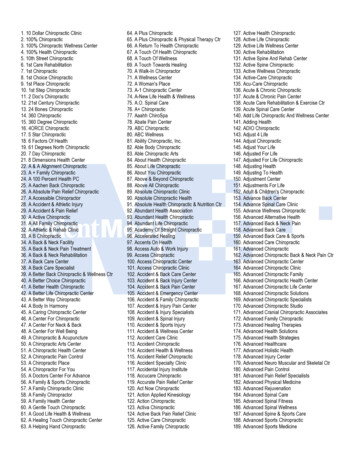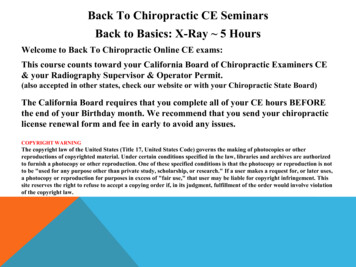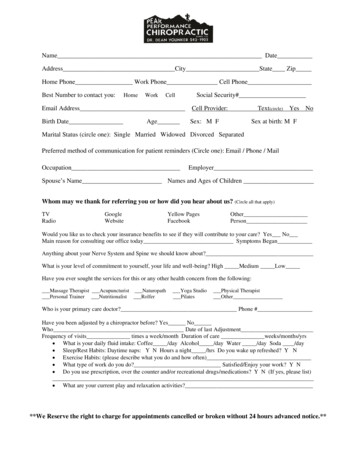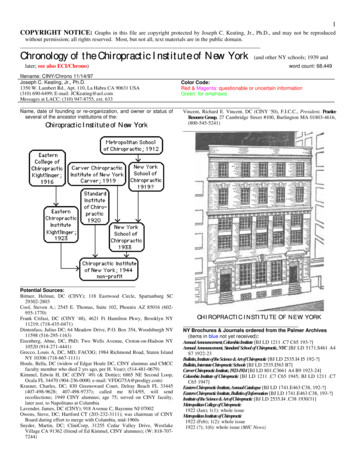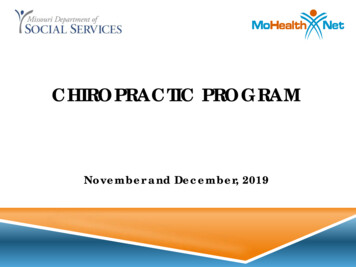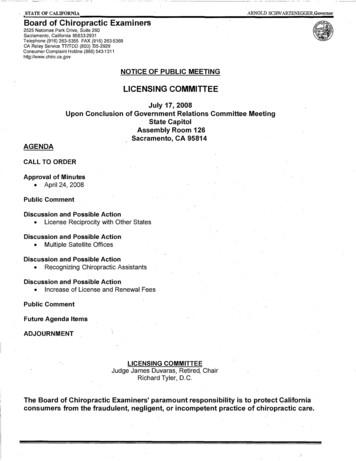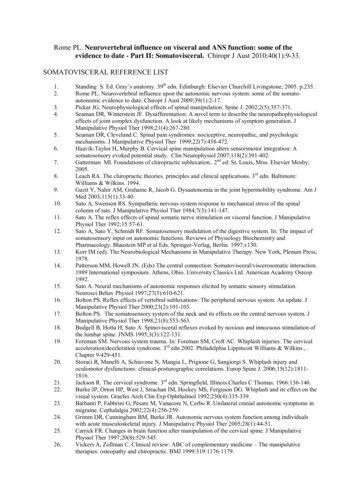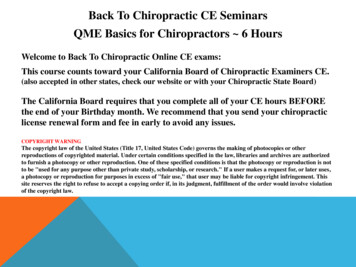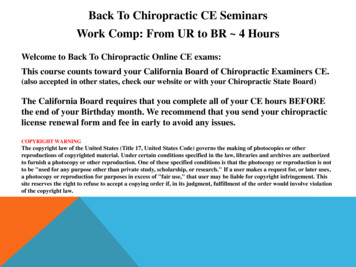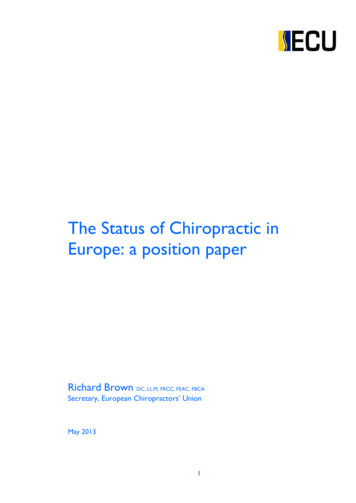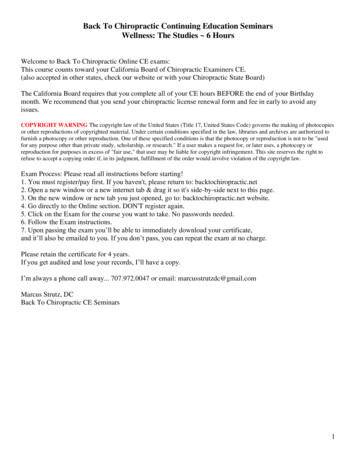
Transcription
Back To Chiropractic Continuing Education SeminarsWellness: The Studies 6 HoursWelcome to Back To Chiropractic Online CE exams:This course counts toward your California Board of Chiropractic Examiners CE.(also accepted in other states, check our website or with your Chiropractic State Board)The California Board requires that you complete all of your CE hours BEFORE the end of your Birthdaymonth. We recommend that you send your chiropractic license renewal form and fee in early to avoid anyissues.COPYRIGHT WARNING The copyright law of the United States (Title 17, United States Code) governs the making of photocopiesor other reproductions of copyrighted material. Under certain conditions specified in the law, libraries and archives are authorized tofurnish a photocopy or other reproduction. One of these specified conditions is that the photocopy or reproduction is not to be "usedfor any purpose other than private study, scholarship, or research." If a user makes a request for, or later uses, a photocopy orreproduction for purposes in excess of "fair use," that user may be liable for copyright infringement. This site reserves the right torefuse to accept a copying order if, in its judgment, fulfillment of the order would involve violation of the copyright law.Exam Process: Please read all instructions before starting!1. You must register/pay first. If you haven't, please return to: backtochiropractic.net2. Open a new window or a new internet tab & drag it so it's side-by-side next to this page.3. On the new window or new tab you just opened, go to: backtochiropractic.net website.4. Go directly to the Online section. DON'T register again.5. Click on the Exam for the course you want to take. No passwords needed.6. Follow the Exam instructions.7. Upon passing the exam you’ll be able to immediately download your certificate,and it’ll also be emailed to you. If you don’t pass, you can repeat the exam at no charge.Please retain the certificate for 4 years.If you get audited and lose your records, I’ll have a copy.I’m always a phone call away. 707.972.0047 or email: marcusstrutzdc@gmail.comMarcus Strutz, DCBack To Chiropractic CE Seminars1
Wellness: The Studies 6 HoursLearning ObjectivesPresented by: Marcus Strutz, DC1. To be aware of the demographics changes of our country and how it will affect the type of patientscoming into our offices. To provide patients with information and strategies to make healthy choices andhow chiropractic is an integral part of that decision. To guide patients to healthier choices and makethem aware of the unhealthy choices.2. To inform chiropractors of the adverse effects of drug therapy, their impact on the health of our patients,and viable options for the chiropractic office. The importance of staying health, which in turn lowers andor prevents the need for drug therapy.3. To explain how to decrease the risk of: Cancer, Hypercholesterolemia, Hypertension, Ulcers withhealthy choices and avoiding the known risk factors.4. How to incorporate the key factors of health (diet, exercise, stress reduction, proper rest), into a practiceon a daily basis and how they relate to chiropractic. Literature is provided to support the validity of thesehealth areas that are useful for both the chiropractor and patient.5. The physiological effects of healthy living will be given as well as “how to” lists for increased patientcompliance.OutlineTimeHours 1-2Hour 3Hours 4-6Topic Demographics of our Nation: Overview of population growth trends, aging statistics, factorsthat attribute to the aging, morbidity and mortality rates and the fall-out on health issues andinsurance costs. Why to stay healthy and avoid the adverse effects of drug therapy: A review of the growth oflegal drug use in the US, including sales figures, the public demand for them and how themedia effects our decision making. A closer look at flu vaccine, aspirin, acetaminophen,naproxen; including peer reviewed literature on the health risks and costs for individuals andour nation. National data is shown in terms of morbidity & mortality rates as well as economic costs ofour nation’s primary killers: Cancer, Hypercholesterolemia, Hypertension and Ulcers.Alternative choices and a “why you should” and “how to” methodology is presented. Key factors of health (diet, exercise, stress, rest). Each factor is reviewed in detail with peeredreviewed literature on the impact it has on overall health. Eating habits, exercise regiments,the epidemic of obesity, the importance of rest and sleep, emotional and physical stress, arereviewed. Includes the physiological effects of diet, exercise, stress and rest; and methods to implementthese factors into chiropractic practice and the patient’s daily life.2
Marcus Strutz, DCLife Chiropractic College West GraduateJune 1996, Summa Cum LaudeProfessor Life Chiropractic College West, 1997-2002 Spinal Biomechanics (authored course manual) Physiotherapy Rehab (authored course manual) Physiotherapy Modalities (authored course manual) X-Ray Physics (authored course manual) Philosophy I Philosophy V - Practice Management Microbiology Lab Systemic Physiology LabPrivate Practice, 2000-present Mendocino/Ft Bragg, CACE Seminars, 2002-present: Technique, Wellness, Physiotherapy, History & ExamGhost Writer Practice Management, 2007-presentNational Board Review Instructor, 1999-2000Dr. Irene Gold & Dr. John DonofrioFather: Amuel Strutz DC Palmer Grad 1961The Alternative! Don’t wait until you are sick, maintain your health! The goal is to live long & behealthy, achieving a more effective life, maintaining full function & well-being. The goal of chiropracticcare is correction of dysfunction w/pain relief, restored function & enhancement of well-being. DC’smake pts aware of their role & responsibility in maintaining their health.“People increasingly see conventional medicine not as health care but as disease care. People want more thanthat. It’s irrational to always wait until one develops a problem to pay attention to health.” Larry Dossey, MDTo start off with Wellness we need to take a look at the demographics of our country, the history and currenthabits. Once we identify the ills of health, we then can move forward and make educated decisions on how tostay healthy versus waiting until we are sick.Population, Life Expectancy & Health Care100 Years Ago! Life expectancy in US 47 yrs, 8% of homes had a phone, 8,000 cars & 144 miles of pavedroads, Population of Las Vegas was 30, Average US worker made 200- 400/year, Babe Ruth made 50,000 in1920, 95% of births took place at home, 6% had graduated from high school, Canada passed a law prohibitingpoor people from entering, 230 murders in entire US, 124 in Oakland in 2008, 90% of US physicians attendedmedical schools, condemned by the press & government as “substandard”.Top 5 Causes of Death 100 Years Ago: 1. pneumonia/flu, 2. TB, 3. diarrhea, 4. heart disease, 5. stroke.State of the World If there was 100 people in the world today: 20 would be children, 80 would be adults,14 would be 65 or older. There would be: 61 Asians, 12 Europeans, 13 Africans, 14 people from the WesternHemisphere. Religion: 31 Christians, 21 Muslims, 14 Hindus, 6 Buddhists, 12 people believe in other religions,16 not aligned with a religion. Language: 17 would speak Cantonese or Mandarin, 8 would speak Hindi,8 would speak English, 7 would speak Spanish, 4 would speak Arabic, 4 would speak Russian, 52 would speakother languages. How Lucky Are We?: 82 could read & write, 1 would have a college education, 1 would own acomputer, 75 would have some food supply & shelter from wind & rain, 1 would be dying of starvation,3
17 would be undernourished, 15 would be overweight, 83 would have access to safe drinking water.When one considers our world from such a compressed perspective the need for acceptance,understanding & education becomes glaringly evident. University of Wisconsin, 2006 .California 508,000US Bureau of the Census, July 2007Life Expectancy at Birth, 2006United Nations World Population ProspectsCountryAge1Monaco89.82Macau84.43San apore82.18Hong Kong82.09Australia81.710Canada81.349USA78.2Healthy Life ExpectancyWHO, 2009#CountryTotal @ Birth1Japan782 San Marino763Sweden764 Switzerland765Monaco7629USA72Top 10 Causes of DeathUS National Center for Health Statistics, 2007Total deaths: 2,423,712CauseDeaths% of Total1 Heart disease616,06725.4%2 Cancer562,87523.2%3 Stroke135,9525.6%4 Lung diseases127,9245.3%5 Accidents123,7065.1%6 Alzheimer's74,6323.1%7 Diabetes71,3822.9%8 Influenza/Pneumonia52,7172.2%9 Kidney diseases46,4481.9%10 Septicemia34,8281.4%Life Expectancy at Birth, 1930–2006National Center for Health Stats, 8196069.7195068.2194062.9World Rankings Health Care Systems1. France2. Italy3. San Marino4. Andorra5. Malta6. Singapore7. Spain8. Oman9. Austria10. Japan37. USAWHO, 20054
Why Is The US So Unhealthy? Stress, Pills, Diet, Smoking & Drinking Native Americans, rural African Americans & inner city poor have extremely poor health, more like apoor developing country HIV: higher rate of death to US young & middle-aged than in most advanced countries High cancer rate from tobacco use High coronary heart disease rate High number of homicides High number of obese peopleAlcohol Consumption WHO 2007Liters per capita1. Luxembourg12.62. Hungary11.43. Czech Republic11.04. Ireland10.85. Germany10.26. Spain10.07. Portugal9.68. UK9.69. Denmark9.510. Austria9.326. US6.8McDonald's# of restaurants per million1. US45.62. New Zealand38.13. Canada36.24. Australia35.95. Japan28.36. Sweden25.67. UK18.78. Denmark18.49. Austria18.110. Finland17.9Drug Expenditure Per CapitaOECD Health Data, 20091. US 8782. Canada 6913. Greece 6774. France 5885. Belgium 5666. Spain 5627. Germany 5428. Italy 5189. Austria 50010. Switzerland 454Stressed Americans! 5th most stressed & 33rd in smiling! 151 nations surveyed. Time, 2010Smoking:As we go through the notes I am providing information and unhealthy things like smoking. If we can share thisinformation with our patients then perhaps we can get them on track towards wellness.In 2009 43 million or 20.4% of adults were current smokers.CDC/NCHS, National Health Interview Survey, 200950% of high school students tried smoking. 25% of kids age 12 or older currently smoke. CDC, 2009 440,000 die in US each yr from tobacco use. Cigarettes kill more Americans than alcohol,car accidents, suicide, AIDS, homicide & illegal drugs combined. Cigarette smoking life expectancy 6.8 yrs Stopping at age 40 life expectancy 4.6 yrs & disease-free life-yrs 3!American Cancer Society, April 2007599 Ingredients in Cigarettes: quitsmokingsupport.comCigarette smoke contains over 4,800 chemicals, 69 of which are known to cause cancerCancer Causing Agents: Nitrosamines, Crysenes, Cadmium, Benzo-pyrene, Polonium 210, Nickel,Diberiz Acidine, B-Napthylamine, Urethane, Nitrosonornicotene, ToluidineMetals: Aluminum, Zinc, Magnesium, Mercury, Gold, Silicon, Silver, Titanium, Lead, Copper5
Acetone (nail polish remover), Acetic Acid (vinegar), Ammonium (toilet cleaner), Arsenic (poison),Butane (lighter fluid), Cadmium (rechargeable batteries), Carbon Monoxide (car exhaust), DDT (insecticides),Ethanol (alcohol), Formaldehyde (preserver of body tissue), Hexamine (barbecue lighter), Hydrogen Cyanide(gas chamber poison), Methane (swamp gas), Methanol (rocket fuel), Napthalene (mothballs), Nicotine(addictive drug), Nitrobenzene (gasoline additive), Nitrous Oxide Phenols (disinfectant), Steric Acid(candle wax), Toluene (industrial solvent), Vinyl Chloride (makes PVC)Glantz, S. 1992. Tobacco: Biology and Politics. Health Edco, Waco TX1982 Surgeon General's Report “Cigarette smoking is the major single cause of cancer mortalityin the US & is the most preventable cause of premature death.”When They Told Us! Surgeon General Luther Terry documented that smoking causes lung cancer.Released on January 11, 1964.Smoking has declined 40% from 1965-1990, but has changed little since. CDC, June 2005Tobacco Industry Increases Addictive Nicotine in Cigarettes From 1998-2004 manufacturers theamount of addictive nicotine by 10%. 166 of 179 cigarette brands fell into the highest nicotine range,including 59 brands labeled "light" & 14 labeled "ultra-light." NY Times, Aug 2006When They Knew: 1925 Frederick Hoffman, San Francisco Cancer Survey 1925, data showed prematuredeaths among smokers at a higher rate than among nonsmokers. "Cancer Studies . . . Habits, Characteristics andEnvironment of Individuals With And Without Cancer," NEJM, April 1928.Drs. Lombard & Doering, 1925. "The use of tobacco has long been considered a factor in the incidence ofcancer of the buccal cavity . . . Heavy smoking is more common in the cancer group than among the controls."Start Moving, Stop Smoking Smokers can cut their cravings & withdrawal symptoms by exercising.5 mins of walking or moderate isometrics can help overcome nicotine cravings. Researchers weresurprised, reporting it to be as effective for acute cravings as a nicotine patch. AP, March 2007CancerCancer is a great example of how people feel helpless and that you simply “catch cancer”. It is our dutyto inform our patients on the best strategies in avoiding cancer.The #2 cause of death in the US! 562,875 die/yr 1,542/dayUS National Center for Health Statistics, 2007In 2008 cancer costs: American Cancer Society, 2008 93.2 billion direct medical costs Total 228.1 billion11.7 million people (1 in 26) are currently diagnosed with cancer. By 2020 the number will to 18.2 million (1 in 19) A 56% the US may face a shortage of 4,000 cancer specialists!Journal of Oncology Practice, March 2007What If We Were Healthier? Maybe We Would Need FEWER Specialists!6
Cancer: Common PresentationComplains of persistent insidious onset of painUnexplained weight lossFatiguePain worse at nightPain does not change with motionCare for 1 month with no changeSore that does not healUnusual bleeding or dischargeThickening or lump in breast or elsewhereIndigestion or difficulty in swallowingObvious change in a wart or moleNagging cough or hoarseness3 Categories of nsDrinkingSun ExposureLack of ExerciseCancer & Lifestyle FactorsPoor diet & obesity30%Smoking30%Genetics10%Carcinogens in the workplace 5%Family History5%Lack of Exercise5%Viruses5%Alcohol3%Reproductive Factors3%Socioeconomic Status3%ExternalWorkplaceAir pollutionWater pollutionChemicalsPesticides/HerbicidesPoor diet, lack of exercise & unhealthy lifestyle are responsible for 65% of cancer deaths!American Cancer Society, 2006Fiber & Bowel Cancer Those with the highest intake of fiber from grains, relative to those with the lowest,had a 49% reduction in the risk of developing small bowel cancer. Gastroenterology, Oct 2008Probable Cause: DNA damageHow Cells Work Oxygen, water & nutrients get to the cell via the bloodstream The cell does its’ “metabolic job” Waste products are then excreted via the bloodstream If the waste doesn’t get excreted it becomes toxic & can cause pain via muscular tighteningand/or trapping of chronic inflammatory chemicals If this persists the cells may become cancerousAdjustments the respiratory burst in phagocytes to help engulf & destroy invasive organisms,thus boosting the immune system. JMPT, 1991Exercise: Cancer is less prevalent in active people, as exercise depression & oxygen to the tissuesHarvard Medical SchoolHow to Prevent Cancer Women who followed at least 6 of 9 recommendations were 35% less likely to getcancer & 43% less likely to die from cancer than women who did zero or one.Cancer Epidemiology, Biomarkers & Prevention, July 20047
How To Decrease The Risk Of Cancer1. max BMI of 25, limit adult weight gain to 11 lbs.(daily moderate/wkly vigorous activity)2. eat 5 or more servings of fruits & veggies daily3. eat 7 or more portions of complex carbs daily4. processed foods & refined sugars5. limit alcoholic drinks: 1-women, 2-men daily6. limit red meat to no more than 3 oz daily7. fatty foods, particularly animal fats8. limit intake of salted foods & use in cooking9. eliminate tobacco use*Always consult with your doctor/chiropractor before starting any health related program.Breathing & OxygenOne of the healthiest things you can do for yourself is regular slow deep breathing exercises. Chiropracticis one of the very few professions that improves breathing through adjustments and postural alignment.Advice: Take 5-10 Deep breaths per hourHow Long Will You Live? 6 mins without oxygen, 10 days without water, 4-6 wks without foodRespiratory System After age 20 vital capacity 5-20% per decade (maximum volume of air that aperson can exhale after maximum inhalation).Brian K Ross MD, University of WashingtonOxygen: Creates energy (defeats fatigue), Aids in digestion, Cleans & detoxifies, Metabolizes fats & carbs,Transports gases across cell membranes, Makes hormones & proteins, Regulates pH, Maintains a strongimmune systemSymptoms of O2 Starvation: Circulation problems, Memory loss, Irrational behavior, Irritability,Poor digestion, Muscle aches & pains, Lung problems, Dizziness, Acid stomach, Depression, Body weakness,Fatigue, Growth of pathogens"Starved of oxygen the body will become ill & if this persists it will die." Dr. John Muntz“Virus, amoeba, parasites, fungi & bacteria cause many diseases! None of those hostile organisms can livein an environment with high concentrations of oxygen. Oxygen gets rid of toxicity. These pathogens aredestroyed in the presence of oxygen - especially cancer.” Dr. Alec Borsenko"In all serious disease we find a low oxygen state. Hypoxia in the tissues is the fundamental cause for alldegenerative disease." Dr. Stephen Levine, Oxygen Deficiency: A Concomitant to All Degenerative Illness“Cancer has one prime cause. The replacement of normal oxygen respiration of the body's cells by ananaerobic (oxygen-deficient) respiration.” Dr. Otto Warburg 1883-1970 Winner Nobel Prize 1931The best health care is free; be proactive & take care of yourself before you have symptoms. Marcus Strutz8
Healthy Insurance?High health insurance costs are another great reason to stay healthy.US Health Care Expenditures Centers for Medicare and Medicaid Services, 2010 2.47 trillion 2009 714 billion 1990 253 billion 1980In 2009 spending was 7681 per resident & 17.3% of the GDP, amongst the highest of all industrializednations!Spending Too Much! US spends 480 billion in excess as compared to Western European nations that haveuniversal health insurance. The costs are mainly associated with excess administrative costs (6x more percapita) & poorer quality of care. McKinsey Global Institute. Jan 2007OECD Health Data, 2010National Health Expenditures, 2008The Uninsured 46.3 million, 15.4 % of Americans are uninsured! CDC, 2009Americans spent 138.5 billion in out-of-pocket health care expenses. US Bureau of Labor Statistics, 2010 43 billion, 1/3 of out-ofpocket spending went toprescription drugs.23% of the uninsuredchanged their life to paymedical bills. Every 30seconds someone files forbankruptcy after a serioushealth problem.National Coalition onHealth Care, 2008Out Of Here? Surgery: 200,000 vs 8,000Medical TourismTom Hiland 800.466.95029
Public Surveys On Health Care The public has many misconceptions about health. Confused by advertising they struggle to makehealthy choices and often do unhealthy things thinking they are being smart. 48% worry about the safety of health care 50% of chronic condition pts experienced a medical error 14% filed malpractice lawsuits 55% were dissatisfied with the quality of care, up from 44% just 4 yrs ago 33% who saw a printed drug ad didn’t notice the small print summarizing a drug's risks & side-effects Of those who did notice the print, only 33% said they read it 66% of participants shown drug ads said they learned "little or nothing" about the condition 59% said they learned "little or nothing" about the drug 43% of respondents believe only drugs that are "completely safe" can be advertised! 46% of respondents would be "disappointed" if their doctor turned down the pt's request for anadvertised drug 15% said they would consider switching physicians!Perceived Causes of Preventable Errors Harvard School of Public Health, 2006Perceived CausesPublicDoctorsNot enough time w/ pts72%37%Overwork, stress or fatigue70%50%Not enough nurses65%53%Influence of HMOs62%39%Poor training54%28%Poor supervision50%16%Poor handwriting48%21%Uncaring attitude47%15%Lack of computer records35%13%Be Smart Never tell a patient to get off a prescription medication, just provide information for them.Always consult with a physician or resource to see if there is an interaction effect with any drug, vitamin,mineral, herb, food, lifestyle or condition.What happened to prevention & proactive health care?US Consumed By DrugsTypically people wait until they are sick and then they try to regain health with pharmaceutical drugs.Americans make up 5% of the world’s population but consume 50% of all prescription drugs. The globalpharmaceutical market grew to 808 billion in 2009 at a compound annual growth rate of 9.3% between 1999 &2009. URCH Publishing, 2010Now That’s Excessive! The New England Journal of Medicine defines excessive medication as more than1,000 pills in a lifetime or more than 365 in a year!Addicted? 51% of US children & adults are taking one or more prescription drugs for a chronic condition!Medco Health Solutions Inc, 2008People with at least one prescription from 67% in 2000 to 74% in 2006. Express Scripts, 200810
Retail Prescriptions 2009 Total 3.5 billion Sales 300.3 billion per capita 11.8 IMS Health, 2010#12345678910Top 10 Drugs by Sales 2009ProductUS SalesLipitor 5.4 billionNexium 5.0 billionPlavix 4.2 billionAdvair Diskus 3.7 billionSeroquel 3.1 billionAbilify 3.1 billionSingulair 3.0 billionOxyContin 3.0 billionActos 2.5 billionPrevacid 2.5 billiondrugs.comUsed ForCholesterolGI disordersThrombic eventsAsthmaDepressionAntipsychoticAllergyPain ReliefDiabetesAcid StomachDrugs in our daily life! Pew Internet & American Life Project, Oct 2004 64% of US households are regular consumers of prescription drugs 45% of adults take prescription drugs on a regular basis 41% of adults live with someone who regularly takes prescription drugs 27% occasionally take prescription drugs 27% say they never take prescription drugsCancer DrugsAbraxane made 200 million in 2006 & pts didn’t live longer! The older version Taxol has similar effects& costs 25x less 986 a dose. Pts want the newest & most expensive drugs. Insurers rarely deny coveragebased on price. Worldwide sales are expected to reach 80 billion by 2012! IMS Health, 2009Drugs: High PricesThe crazy high cost of not being healthy. Once you become sick the cost of regaining health is extreme oftenleading to bankruptcy.“It's really exploiting the desperation of people with a life threatening illness.”New England Journal of MedicineAt What Cost? More than 90% of cancer agents approved by the FDA in the past 4 yrs cost 20,000 fora 12 wk course of therapy! Journal of the National Cancer Institute, 20092008 sales of cancer drugs in the US were 19.2 billion, in 1998 sales were 5 billion. IMS Health, 2009Longer Life, Higher CostDrugs for colorectal cancer:1996: 500 Expected survival: 11 monthsToday: 250,000 Expected survival: 24 months (perhaps due to earlier detection)Memorial Sloan-Kettering Cancer Center, 2006Spending Drug companies spent 57.5 billion on marketing, dwarfing the 31.5 billion devoted to research!The Cost of Pushing Pills, 200811
2007 Salaries for the CEO’s American Chronicle, Nov 20081. Miles White - Abbot 33.4M2. Fred Hassan - Schering-Plough 30.1M3. Bill Weldon - Johnson & Johnson 25.1M4. Bob Essner - Wyeth 24.1M5. Robert Parkinson - Baxter 17.6M6. Daniel Vasella - Novartis 15.5M7. Richard Clark - Merck 14.5M8. Frank Baldino - Cephalon 13.5M9. Sidney Taurel - Eli Lilly 13.0M10. Jeff Kindler - Pfizer 12.6MThe Pushers Meds for kids under 19 28% last year. Heartburn & other GI disorders in kids 660% in past 5 yrs. CDC Concept of good nutrition & parenting?Spending on antibiotics among kids 42%. CDCCorporate pushers aren't concerned about health, they just want you feeling better. Someone has to let themknow that true health doesn't come from a pill.If drugs are the solution why do US consumers need more every year? Are we addicted?New Drugs: Not Always Better or Safer New drugs are promoted more vigorously, pts & doctors requestthem thinking a new drug must be better. Generic drugs were found to be cheaper & more effective atlowering BP. Treating high BP with generic drugs could save the US health care system 10 billion yearly.USA Today, Oct 2006“Pts are spending more money believing they are getting a superior pain & inflammation reliever,but evidence to support that is just not there.” Dr. Sharon Levine Kaiser PermanenteThe Worst? anticoagulant Trasylol Between 1999 & 2005 Bayer made 935 million from sales,with 353 million in 2005. Bayer forecasted Trasylol would generate 600 million annually.The drug caused kidney failure. 242,000 deaths have been attributed to Trasylol from 1993 to May 2008.From amicus brief in the US Supreme Court, August 2008Health is a process, not an event. Marcus Strutz, DCDaily Aspirin TherapyAspirin is quick, easy and inexpensive. People think it is a great pain killer and preventive measure forcardiovascular problems.Americans consume more than 80 million aspirin tablets per day! 16,000 tons of aspirin tablets a year!NY Times, 2004Aspirin: The 8th Wonder of The World? Roman Coliseum, Taj Mahal & aspirin? 74% of American’s believethat aspirin should be one of the 8 Wonders of the World! PR Newswire, August 200712
In 1988 researchers found taking aspirin daily could heart attacks by 50%, (later adjusted to 32%),& that men suffered more strokes. Due to this "side effect" (plus a limited study group) researchers warnedNOT to take aspirin to prevent heart disease. A day after it was published in JAMA, aspirin makers(who were given advance notice of the publication) flooded the media with press releases saying "an aspirin aday" could prevent heart attacks. For 23 yrs people have taken aspirin thinking they were protecting their heart.Doctors still believe it & continue to prescribe aspirin to prevent heart attacks.The medical profession agrees! “The routine use of aspirin for the primary prevention of vascular events inpeople with asymptomatic disease cannot be supported.” JAMA, 2010UlcersAnother reason to stay healthy and not take NSAIDS! Peptic ulcers affect 5 million Americans per year 60% of pts with bleeding/perforation have no history of prior symptoms 50% of pts with NSAID ulcers are asymptomaticCDC, 2005Long-term aspirin takers are 68% more likely to have GI bleeding. British Medical Journal, 200035% of NSAID & aspirin users will get GI ulcers! Journal of Clinical Gastroenterology, May 200220% of pts with massive GI tract bleeding were taking aspirin regularly! World Journal of Surgery, May 2002Taking ibuprofen every day for at least 5 yrs a woman's chance of developing breast cancer by 50%!Why is she taking it for 5 yrs? Journal of the National Cancer Institute, June 2005NSAIDS & GI Tract? 103,000 hospitalizations from serious GI complications are related to NSAIDs &16,500 deaths. Ranked 15th for cause of death - similar to AIDS! New England J Med, 1999“There is an increased mortality & cardiovascular morbidity associated with NSAIDs in chronic heart failure.”Archives Internal Medicine, 2009Flu VaccineMost people think the flu vaccine is a great way to stay healthy?Lives Saved By Flu Vaccine Zero? Predictions were that 50% of those vaccinated would not die.Mortality rates from 1968-2001 found no correlation between vaccination rates after 1980 & death rates.National Institute of Allergy & Infectious DiseasesResearchers are now saying earlier studies were flawed & the elderly may not be getting much benefit becausethey fail to produce antibodies in response to the vaccine. Natural immunity may be responsible for the earlierperceived benefits. Archives Internal Medicine, 2005Who Got The Flu Shot? 70.5% ages 65 yrs and over 40.7% ages 50-64 23.6% ages 18-49CDC/NCHS, National Health Interview Survey, 2009Only 40% of US Health Workers Get Immunized! Doctors & nurses say they're too busy. Some healthworkers believe that flu shots don't work & that they cause the flu. Health workers say they've been exposed toso many germs that they're immune. CDC, Sept 200713
Why Don’t Doctors & Nurses Constantly Get Sick?Do you take the flu vaccine? Did you get the flu? Do you tell your pts? Rarely have I met a DC that has takenthe flu vaccine.Items in vaccines: Cynthia Cournoyer, "What About Immunizations? Exposing the Vaccine Philosophy"Phenol (carbolic acid), deadly poisonFormaldehyde, known carcinogenThimerosal, toxic heavy metalAluminum phosphate, deodorants & toxicAluminum/oil adjutants, carcinogen in miceAcetone, fingernail polish removerSV40 virus (similar to AIDS virus), in African green monkeys & in polio vaccinePreventing The Flu Coordinating Center for Infectious Diseases, Oct 2006C careful hygieneC avoid crowds/sneezersF plenty of restF balanced dietF lots of fluidsF stress managementF regular exerciseThis list could be for most diseases!Quickly give a letter grade to Americans on the above list and you will see why we are so sick.I have put my own grades in front of each category, see if you agree."We constantly touch our mouth, nose & eyes, these mucous membranes are welcome mats for cold &flu viruses, which are easily transferr
This course counts toward your California Board of Chiropractic Examiners CE. (also accepted in other states, check our website or with your Chiropractic State Board) . medical schools, condemned by the press & government as "substandard". Top 5 Causes of Death 100 Years Ago: 1. pneumonia/flu, 2. TB, 3. diarrhea, 4. heart disease, 5 .
